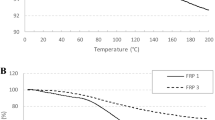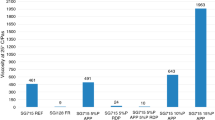Abstract
Two small scale test series were performed using the cone calorimeter heating method to detect any differences in the way various fibres affect the thermal properties of a standard mortar. The cone shaped heater of the cone calorimeter produces a uniform heat flux on the sample surface over an area of 100×100 mm2. The heat flux was adjusted to 50 kW m−2, which corresponds to the early stage of a fully developed fire. The total exposure also corresponds roughly to the ISO 834 time-temperature curve during the first 30 minutes. Short ageing of the specimens gave very clear differences in thermal properties between fibre mortars. However, no such differences were observed with oven dried samples. This shows the importance of carrying out tests in conditions as close as possible to the end use conditions of the material or product.
Resume
Deux séries limitées d'essais ont été effectuées en utilisant la méthode de chauffage par calorimètre conique afin de détecter les différences d'action de diverses fibres sur les propriétés thermiques d'un mortier normalisé. L'élément de chauffage en forme de cône du calorimètre conique envoie un flux de chaleur uniforme sur la couche superficielle de l'éprouvette sur une surface de 100×100 mm2. Le flux de chaleur était réglé à 50 kW m−2, ce qui correspond à l'étape initiale d'un feu bien nourri. L'exposition totale également correspond environ à la courbe de température en fonction du temps durant les 30 premières minutes selon ISO 834. Pour un vieillissement court, on a observé de nettes différences entre les propriétés thermiques des CCF. Or, aucune différence de ce genre n'a été observée avec des éprouvettes séchées en étuve. Ceci prouve l'importance des essais effectués dans des conditions aussi proches que possible des conditions d'utilisation finale du produit ou du matériau. Les essais effectués sur des échantillons de taille réelle nécessitent un vieillissement plus long avant d'atteindre l'équilibre. Or, en réalité, cet équilibre s'établit si lentement que les structures sont en service bien avant qu'il soit atteint. Ceci peut signifier que des teneurs en humidité plus élevées et des temps de vieillissement plus courts que ceux qui ont été utilisés lors de ces essais doivent éventuellement être pris en considération dans l'évaluation du comportement au feu des matériaux et des produits. La méthode du calorimètre conique est un outil efficace et avantageux pour évaluer le comportement au feu des différents CCF. Le niveau de définition de la méthode est avantageux car il permet d'identifier les cas de fissuration superficielle (même à différents niveaux d'humidité des éprouvettes) et elle donne des évaluations claires de l'efficacité des différentes fibres.
Similar content being viewed by others
References
Jumppanen, U.-M., ‘Effect of strength on fire behaviour of concrete’,Nordic Concr. Res. 8 (1989) 116–127.
Bansal, R. C. and Donnet, J. B., ‘Pyrolytic formation of high-performance carbon fibres’, in ‘Comprehensive Polymer Science’, Vol. 6, ‘Polymer Reactions’. (Pergamon Press, Oxford, 1989) pp. 501–520.
Czernin, W., ‘Cement Chemistry and Physics for Civil Engineers’, 2nd Engl. Edn (Godwin, London, 1980).
Miller, A., ‘Sätt att armera betongmassa med stålfibrer’, Pat. SE 460 118 (AB Inst. för Innovationsteknik, Stockholm, 1989).
Staf Hansen, A. and Davies, D., ‘Fibres and material comprising same’, Pat. WO 90/06902 (Danaklon A/S, Varde Denmark, 1990).
Sarvaranta, L., Järvelä, E. and Mikkola, E., ‘Fibre mortar composites under thermal exposure’, in Proceedings of 2nd International Symposium on Textile Composites in Building Construction, Lyon, France, 23–25 June 1992 (Pluralis, Paris, 1992), Part 1, pp. 47–56.
Sarvaranta, L. and Mikkola, E., ‘Fibre mortar composites in fire conditions’,Fire Mater.18 (1994) 45–50.
Sarvaranta, L., Elomaa, M. and Jävelä, E., ‘A study of spalling behaviour of PAN fibre-reinforced concrete by thermal analysis’,Fire Mater.17 (1993) 225–230.
Babrauskas, V., ‘Development of the Cone Calorimeter—A Bench Scale Heat Release Rate Apparatus Based on Oxygen Consumption’, (US National Bureau Standards, Washington DC, 1982).
‘Standard test method for heat and visible smoke release rates for materials and products using an oxygen consumption calorimeter’, ASTM E 1345-90 (American Society for Testing and Materials, Philadelphia, 1990).
‘Fire tests—Reaction to fire—Rate of heat release from building products (cone calorimeter)’, ISO 5660 (International Organization for Standardization, Geneva, 1990).
Author information
Authors and Affiliations
Rights and permissions
About this article
Cite this article
Sarvaranta, L., Mikkola, E. Fibre mortar composites under fire conditions: effects of ageing and moisture content of specimens. Materials and Structures 27, 532–538 (1994). https://doi.org/10.1007/BF02473214
Issue Date:
DOI: https://doi.org/10.1007/BF02473214




